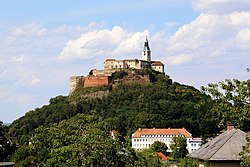You can help expand this article with text translated from the corresponding article in German. (July 2009)Click [show] for important translation instructions.
|
| Schloss Gutenberg | |
|---|---|
| Styria, Austria | |
 | |
| Site information | |
| Type | Castle |
 | |
Schloss Gutenberg is a castle in Styria, Austria. Schloss Gutenberg is situated at a height of 567 meters. [1]
Contents
Schloss Gutenberg stands on a prominent rock by the Raabklamm in Gutenberg an der Raabklamm parish.
The castle is a foundation of Luitold III of Waldstein, who moved into the castle in 1185. The castle has belonged to the Stubenberg family since 1288. The oldest section from the 12th century was supplemented by a 2-story bailey that is protected by two moats. The outer moat is bridged today, the inner was filled in. The castle was remodeled and expanded, mixing the medieval style with Renaissance elements. An irregular four-story building complex with an almost pentagonal footprint and similarly pentagonal courtyard. The rustic gate faces south.







